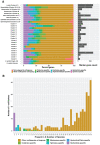This is a preprint.
The genome of the colonial hydroid Hydractinia reveals their stem cells utilize a toolkit of evolutionarily shared genes with all animals
- PMID: 37786714
- PMCID: PMC10541594
- DOI: 10.1101/2023.08.25.554815
The genome of the colonial hydroid Hydractinia reveals their stem cells utilize a toolkit of evolutionarily shared genes with all animals
Update in
-
The genome of the colonial hydroid Hydractinia reveals that their stem cells use a toolkit of evolutionarily shared genes with all animals.Genome Res. 2024 Apr 25;34(3):498-513. doi: 10.1101/gr.278382.123. Genome Res. 2024. PMID: 38508693 Free PMC article.
Abstract
Hydractinia is a colonial marine hydroid that exhibits remarkable biological properties, including the capacity to regenerate its entire body throughout its lifetime, a process made possible by its adult migratory stem cells, known as i-cells. Here, we provide an in-depth characterization of the genomic structure and gene content of two Hydractinia species, H. symbiolongicarpus and H. echinata, placing them in a comparative evolutionary framework with other cnidarian genomes. We also generated and annotated a single-cell transcriptomic atlas for adult male H. symbiolongicarpus and identified cell type markers for all major cell types, including key i-cell markers. Orthology analyses based on the markers revealed that Hydractinia's i-cells are highly enriched in genes that are widely shared amongst animals, a striking finding given that Hydractinia has a higher proportion of phylum-specific genes than any of the other 41 animals in our orthology analysis. These results indicate that Hydractinia's stem cells and early progenitor cells may use a toolkit shared with all animals, making it a promising model organism for future exploration of stem cell biology and regenerative medicine. The genomic and transcriptomic resources for Hydractinia presented here will enable further studies of their regenerative capacity, colonial morphology, and ability to distinguish self from non-self.
Conflict of interest statement
Competing interests: The authors declare no competing financial interests.
Figures





References
Publication types
Grants and funding
LinkOut - more resources
Full Text Sources
